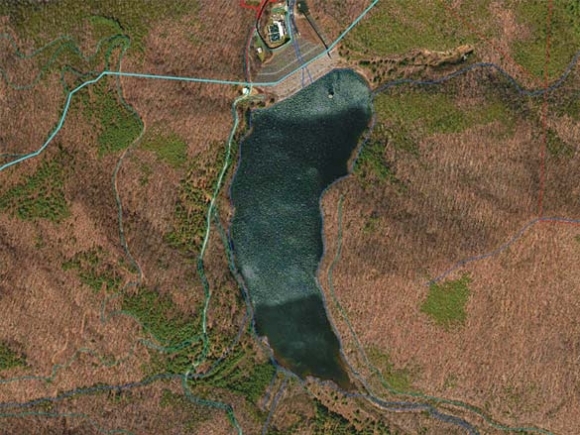Waynesville reservoir study could result in capacity increase

Pristine and nearly untouched by the hands of humans, the Town of Waynesville’s watershed has been hailed as a visionary acquisition by the town since its establishment around 1913.
Classified by the North Carolina Department of Environmental Quality’s Division of Water Resources as WS-I, meaning “essentially natural and undeveloped watersheds with no permitted point source (wastewater) discharges” — the watershed has for decades provided drinking water of exceptional quality to residents and businesses in the area.
It’s doubtful, however, that town leaders of the day could fathom how important it would be in an age where climate change and water scarcity conspire to make such a ubiquitous commodity that much more precious, and indeed a key to economic development and therefore the vitality of the region itself.
“It’s not as important as it used to be, because most water-intensive businesses have moved overseas, namely textiles,” said Rob Hites, Waynesville’s town manager. “But it is still important for certain types of businesses the county may be interested in attracting — namely, computer server banks and water bottling.”
The historic drought of 2016 resulted in water restrictions across the county and across the region; during that time, Waynesville’s massive Allens Creek Reservoir was looked to as a possible source of emergency water distribution for Haywood County’s other municipalities.
“Going back to the drought, as the drought deepened last year we got informal requests from Canton and the Maggie Valley Sanitary District for over 2.5 million gallons of water a day,” said Hites.
Related Items
But according to Town Engineer Preston Gregg, that didn’t add up — the amount of water needed to serve Canton, Clyde and Maggie Valley wasn’t going to be available.
“We don’t have the reservoir capacity to sell that much water continually during a protracted drought,” Hites said.
So back in May, Waynesville officials commissioned a $25,000 study by McGill and Associates to determine exactly how much water the reservoir could provide.
Taking into account the total drainage area of the 13 square-mile watershed and the capacity of the reservoir, McGill and HydroLogics Inc. utilized data from United States Geological Survey to create a computer model of what’s known as the “safe yield” of the reservoir.
That figure will come into play as local water systems look to regionalize their operations in the event that such conditions strike again.
Drought events in Western North Carolina are probably more common than most people realize; disruptions in service — even under restrictions — are rare and not usually noticeable.
Historic data dating back to 1927 show 13 years during which droughts affected the watershed, beginning in 1932. Over those 91 years, almost half of the drought events have occurred in the last 18 years.
Built in 1954, the Town of Waynesville’s water treatment plant — adjacent to the reservoir — can take up to 7 million gallons of water each day, treat it, and deliver it to its 6,400 commercial and residential customers as well as to the Junaluska Sanitary District and Lake Junaluska Assembly.
On average, though, the plant treats about 3.4 million gallons of water per day, and maxed out at 4.5 million gallons one day back in 2016.
McGill used the original 1975 reservoir plans to calculate the volume of the reservoir, including the long-hidden topography submerged below the waterline.
Those plans say that the minimum pool elevation is 3,140 feet above sea level, a full pool is present at an elevation of 3,172 feet, and that the reservoir is full 32 feet above that. The maximum water level is an additional 15 feet above that.
McGill’s projected safe yield at full pool is about 6.3 million gallons per day, and rises by about a million gallons for every additional 10 feet of water added to the pool.
“We need to know if the dam can handle another few feet of water,” Hites said. “I would assume it can, and we know that if we could raise the water just another 10 feet, the region’s ability to use our water for long-term drought would be greater.”
According to the report, presented to Waynesville Aldermen Dec. 12, there are indeed options the town could consider.
If the town wants to increase the safe yield of the Allens Creek Reservoir in order to be ready in times of drought, the most obvious option is to increase the height of the water pool, which would probably require the completion of a dam stability study, as well as its submission to the North Carolina Division of Dam Safety.
McGill also notes in the study that it does not take into account any future population growth in Waynesville; although the town has seen nearly flat population growth in recent years, should population unexpectedly boom, the study wouldn’t reflect the town’s water needs at that point.
Additionally, downstream repercussions can’t be ignored; a cadre of organizations like Haywood County Emergency Management, North Carolina Emergency Management and FEMA would likely become involved to ensure that flooding wouldn’t occur if the pool level was raised.
The report, Hites said, is just the first step in exploring all options to ensure continuous service even in the driest of years.
“The county and local municipalities created a loose working group, and the county has applied for a grant from DNR to fund a regional water study,” Hites said.
If successful they’ll likely engage McGill to recommend changes to the reservoir or treatment plant, and also explore the possibility of interconnections between Waynesville and other users in the county.
“This forms the basis for the study,” Hites said. “It shows the capacity for the only reservoir that provides drinking water in the county.”









